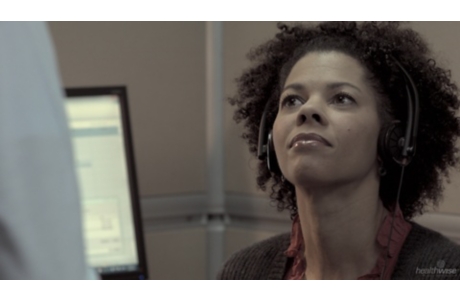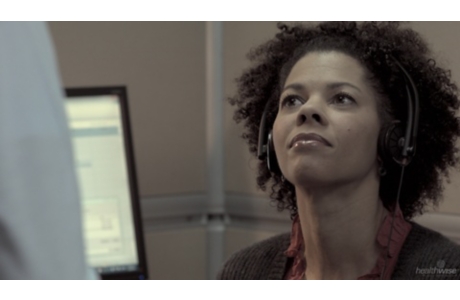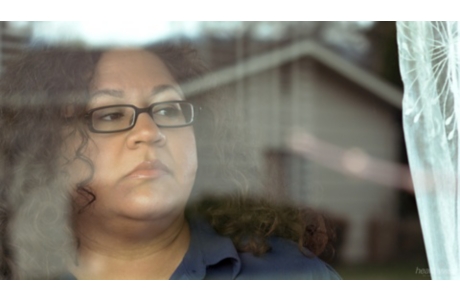Top of the pageCheck Your Symptoms
Anxiety
Overview
Feeling worried or nervous is a normal part of daily life. Everyone frets or feels anxious from time to time. Mild to moderate anxiety can help you focus your attention, energy, and motivation. If anxiety is severe, you may feel helpless, confused, or very worried. But your feelings may be out of balance with how serious or likely the feared event might be. Overwhelming anxiety that interferes with daily life isn't normal. This type of anxiety may be a symptom of an anxiety disorder. Or it may be a symptom of another problem, such as depression, Opens dialog.
Anxiety can cause physical and emotional symptoms. A specific situation or fear can cause some or all of these symptoms for a short time. When the situation passes, the symptoms usually go away.
Physical symptoms of anxiety include:
- Trembling, twitching, or shaking.
- A feeling of fullness in the throat or chest.
- Breathlessness or a rapid heartbeat.
- Lightheadedness, Opens dialog or dizziness, Opens dialog.
- Sweaty or cold, clammy hands.
- Feeling jumpy.
- Muscle tension, aches, or soreness (myalgias).
- Extreme tiredness.
- Sleep problems, such as not being able to fall asleep or stay asleep, early waking, or feeling restless (not feeling rested when you wake up).
Anxiety affects the part of the brain that helps control how you communicate. This makes it harder to express yourself creatively or function well in relationships. Emotional symptoms of anxiety include:
- Feeling restless, grouchy, or on edge or keyed up.
- Worrying too much.
- Fearing that something bad is going to happen. You may feel doomed.
- Not being able to concentrate. You may feel like your mind goes blank.
Anxiety disorders
Anxiety disorders occur when people have both physical and emotional symptoms. These disorders interfere with how a person gets along with others. They also affect daily activities. Women are twice as likely as men to have problems with anxiety disorders. Examples include panic attacks, phobias, and generalized anxiety disorder. When you have generalized anxiety disorder, you feel worried and stressed about many everyday events and activities.
Often the cause of anxiety disorders isn't known. Many people who have them say that they've felt nervous and anxious all their lives. This problem can occur at any age. Children who have at least one parent with the diagnosis of depression are more than twice as likely to have an anxiety disorder than other children.
Anxiety disorders often occur with other problems, such as:
- Mental health problems, like depression.
- Substance use, Opens dialog problems.
- A physical problem, like heart or lung disease. A complete medical checkup may be needed before an anxiety disorder can be diagnosed.
Panic attacks
A panic attack, Opens dialog is a sudden feeling of extreme anxiety or intense fear without a clear cause or when there is no danger. Panic attacks are common. They sometimes occur in otherwise healthy people. They usually last only a few minutes, but they may last longer. And for some people, the anxiety can get worse quickly during the attack.
Symptoms include feeling like you're dying or losing control of yourself, rapid breathing (hyperventilation, Opens dialog), numbness or tingling of the hands or lips, and a racing heart. You may feel dizzy, sweaty, or shaky. Other symptoms include trouble breathing, chest pain or tightness, and an irregular heartbeat. These symptoms come on suddenly and without warning.
Sometimes symptoms of a panic attack are so intense that you may fear that you're having a heart attack, Opens dialog. Many of the symptoms of a panic attack can occur with other illnesses, such as hyperthyroidism, Opens dialog, coronary artery disease, Opens dialog, or COPD, Opens dialog. A complete medical checkup may be needed before an anxiety disorder can be diagnosed.
People who have repeated unexpected panic attacks and worry about the attacks are said to have a panic disorder, Opens dialog.
Phobias
Phobias, Opens dialog are extreme and irrational fears that interfere with daily life. People with phobias have fears that are out of proportion to real danger. They're not able to control the fears.
Phobias are common. They sometimes occur with other conditions, such as panic disorder or Tourette's disorder, Opens dialog. Most people deal with phobias by avoiding the situation or object that causes them to feel panic. This is called avoidance behavior.
A phobic disorder occurs when the avoidance behavior becomes so extreme that it interferes with your daily activities. There are three main types of phobic disorders:
- Fear of being alone or in public places where help might not be available or escape is impossible (agoraphobia, Opens dialog).
- Fear of situations where you might be exposed to criticism by others (social phobia, Opens dialog).
- Fear of specific things (specific phobia).
Phobias can be treated to help reduce feelings of fear and anxiety.
Related Videos
Health Tools help you make wise health decisions or take action to improve your health.
The medical assessment of symptoms is based on the body parts you have.
- If you are transgender or nonbinary, choose the sex that matches the body parts (such as ovaries, testes, prostate, breasts, penis, or vagina) you now have in the area where you are having symptoms.
- If your symptoms aren’t related to those organs, you can choose the gender you identify with.
- If you have some organs of both sexes, you may need to go through this triage tool twice (once as "male" and once as "female"). This will make sure that the tool asks the right questions for you.
Many things can affect how your body responds to a symptom and what kind of care you may need. These include:
- Your age. Babies and older adults tend to get sicker quicker.
- Your overall health. If you have a condition such as diabetes, HIV, cancer, or heart disease, you may need to pay closer attention to certain symptoms and seek care sooner.
- Medicines you take. Certain medicines, such as blood thinners (anticoagulants), medicines that suppress the immune system like steroids or chemotherapy, herbal remedies, or supplements can cause symptoms or make them worse.
- Recent health events, such as surgery or injury. These kinds of events can cause symptoms afterwards or make them more serious.
- Your health habits and lifestyle, such as eating and exercise habits, smoking, alcohol or drug use, sexual history, and travel.
Try Home Treatment
You have answered all the questions. Based on your answers, you may be able to take care of this problem at home.
- Try home treatment to relieve the symptoms.
- Call your doctor if symptoms get worse or you have any concerns (for example, if symptoms are not getting better as you would expect). You may need care sooner.
A few examples of obsessive or compulsive behaviors that can interfere with your daily activities include:
- Frequently washing your hands, showering, or brushing your teeth.
- Constantly cleaning, straightening, and ordering certain objects.
- Checking lights, appliances, or doors again and again to be sure they are turned off or closed.
- Repeating certain physical activities, such as sitting down and getting up from a chair, or saying the same thing over and over.
- Hoarding objects, such as newspapers.
- Avoiding public places or taking extreme measures to prevent harm or embarrassment to yourself or others.
The risk of a suicide attempt is highest if:
- You have the means to kill yourself, such as a weapon or medicines.
- You have set a time and place to do it.
- You think there is no other way to solve the problem or end the pain.
Many prescription and nonprescription medicines can cause anxiety. A few examples are:
- Decongestants.
- Diet pills.
- Steroid medicines.
- Thyroid medicines.
Some illegal drugs, such as cocaine, crack, and speed (amphetamines), also can cause anxiety.
Symptoms of a heart attack may include:
- Chest pain or pressure, or a strange feeling in the chest.
- Sweating.
- Shortness of breath.
- Nausea or vomiting.
- Pain, pressure, or a strange feeling in the back, neck, jaw, or upper belly, or in one or both shoulders or arms.
- Lightheadedness or sudden weakness.
- A fast or irregular heartbeat.
For men and women, the most common symptom is chest pain or pressure. But women are somewhat more likely than men to have other symptoms like shortness of breath, tiredness, nausea, and back or jaw pain.
Based on your answers, the problem may not improve without medical care.
- Make an appointment to see your doctor in the next 1 to 2 weeks, or contact your telehealth provider.
- If appropriate, try home treatment while you are waiting for the appointment.
- If symptoms get worse or you have any concerns, call your doctor or telehealth provider. You may need care sooner.
What are your options for medical care?
Today your options for where to get your medical care are greater than ever before. You may not even have to leave your home to get the care you want and need. You can choose based on what your health problem is and what works best for you.
- Telehealth is a video call with a health care provider. It can be a convenient way to get medical advice or treatment. Some insurers provide access to telehealth that may be available 24 hours a day. Telehealth for less serious problems may cost less and be faster than in-person clinic visits.
- Urgent care and retail clinics are options if you don't have a doctor, you can't or don't want to wait to see your own doctor, or a telehealth visit can’t treat the problem.
- Virtual care from your primary provider or a telehealth service can be delivered through your smartphone, computer, or tablet.
Based on your answers, you may need care soon. The problem probably will not get better without medical care.
- Call your doctor or telehealth provider today to discuss the symptoms and arrange for care.
- If you cannot reach your doctor or telehealth provider or you don't have one, seek care today.
- If it is evening, watch the symptoms and seek care in the morning.
- If the symptoms get worse, seek care sooner.
What are your options for medical care?
Today your options for where to get your medical care are greater than ever before. You may not even have to leave your home to get the care you want and need. You can choose based on what your health problem is and what works best for you.
- Telehealth is a video call with a health care provider. It can be a convenient way to get medical advice or treatment. Some insurers provide access to telehealth that may be available 24 hours a day. Telehealth for less serious problems may cost less and be faster than in-person clinic visits.
- Urgent care and retail clinics are options if you don't have a doctor, you can't or don't want to wait to see your own doctor, or a telehealth visit can’t treat the problem.
- Virtual care from your primary provider or a telehealth service can be delivered through your smartphone, computer, or tablet.
Call 911 Now
Based on your answers, you need emergency care.
Call 911 or other emergency services now.
Sometimes people don't want to call 911. They may think that their symptoms aren't serious or that they can just get someone else to drive them. Or they might be concerned about the cost. But based on your answers, the safest and quickest way for you to get the care you need is to call 911 for medical transport to the hospital.
Where to get help 24 hours a day, 7 days a week
If you or someone you know talks about suicide, self-harm, a mental health crisis, a substance use crisis, or any other kind of emotional distress, get help right away. You can:
- Call the Suicide and Crisis Lifeline at 988.
- Call 1-800-273-TALK (1-800-273-8255).
- Text HOME to 741741 to access the Crisis Text Line.
Consider saving these numbers in your phone.
Go to 988lifeline.org for more information or to chat online.
Seek Care Now
Based on your answers, you may need care right away. The problem is likely to get worse without medical care.
- Call your doctor now to discuss the symptoms and arrange for care.
- If you cannot reach your doctor or you don't have one, seek care in the next hour.
- You do not need to call an ambulance unless:
- You cannot travel safely either by driving yourself or by having someone else drive you.
- You are in an area where heavy traffic or other problems may slow you down.
Where to get help 24 hours a day, 7 days a week
If you or someone you know talks about suicide, self-harm, a mental health crisis, a substance use crisis, or any other kind of emotional distress, get help right away. You can:
- Call the Suicide and Crisis Lifeline at 988.
- Call 1-800-273-TALK (1-800-273-8255).
- Text HOME to 741741 to access the Crisis Text Line.
Consider saving these numbers in your phone.
Go to 988lifeline.org for more information or to chat online.
Seek Care Now
Based on your answers, you may need care right away. The problem is likely to get worse without medical care.
- Call your doctor now to discuss the symptoms and arrange for care.
- If you cannot reach your doctor or you don't have one, seek care in the next hour.
- You do not need to call an ambulance unless:
- You cannot travel safely either by driving yourself or by having someone else drive you.
- You are in an area where heavy traffic or other problems may slow you down.
Call 911 Now
Based on your answers, you need emergency care.
Call 911 or other emergency services now.
After you call 911, the operator may tell you to chew 1 adult-strength (325 mg) or 2 to 4 low-dose (81 mg) aspirin. Wait for an ambulance. Do not try to drive yourself.
Sometimes people don't want to call 911. They may think that their symptoms aren't serious or that they can just get someone else to drive them. Or they might be concerned about the cost. But based on your answers, the safest and quickest way for you to get the care you need is to call 911 for medical transport to the hospital.
R 14.3.0.0
Home treatment, combined with professional treatment, can help relieve anxiety, Opens dialog. Here are some tips to help you cope with anxiety.
- Know your anxiety.
Recognize and accept your anxiety about specific fears or situations. Then make a plan for dealing with it. For example, if you are always worrying about finances, set up a budget or savings plan.
- Don't dwell on past problems.
Change what you can to help you feel more comfortable with present concerns. But let go of past problems or things you can't change.
- Be kind to your body.
- Relieve tension with exercise or massage.
- Try stress-relief techniques that focus on relaxing your mind and your body.
- Get enough rest.
- Practice healthy thinking, and stop negative thoughts. Choose helpful thoughts to replace the unhelpful ones.
- Avoid alcohol, caffeine, chocolate, and nicotine. They may make you more anxious. Some drugs, such as cocaine, crack, and speed (amphetamines), also can cause anxiety.
- Engage your mind.
- Get out and do something you enjoy. For example, go to a funny movie or take a walk or hike.
- Plan your day. Having too much or too little to do can make you more anxious.
- Keep a diary of your symptoms. Or discuss your fears with a good friend. Confiding in others sometimes relieves stress.
- Do things with others.
Get involved in social groups, or volunteer to help others. Being alone can make things seem worse than they are.
- Get support.
Learn about resources available in your community.
- Talk with your human resources officer about counseling benefits that may be available through your employee assistance program.
- Check with your insurance company to see what mental health benefits are available.
- Contact your public health department for information on community mental health programs.
When to call for help during self-care
Call a doctor if any of the following occur during self-care at home:
- Symptoms occur more often or are more severe.
- Symptoms are not getting better.
Learn more
Current as of: July 31, 2024
Author: Ignite Healthwise, LLC Staff
Clinical Review Board
All Healthwise education is reviewed by a team that includes physicians, nurses, advanced practitioners, registered dieticians, and other healthcare professionals.
Current as of: July 31, 2024
Author: Ignite Healthwise, LLC Staff
Clinical Review Board
All Healthwise education is reviewed by a team that includes physicians, nurses, advanced practitioners, registered dieticians, and other healthcare professionals.
This information does not replace the advice of a doctor. Ignite Healthwise, LLC, disclaims any warranty or liability for your use of this information. Your use of this information means that you agree to the Terms of Use. Learn how we develop our content.










